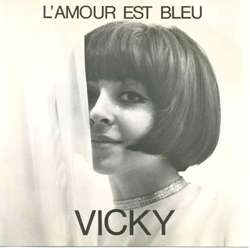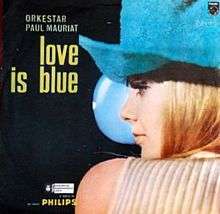L'amour est bleu
| "L'amour est bleu" | |
|---|---|
 | |
| Eurovision Song Contest 1967 entry | |
| Country | |
| Artist(s) | |
| As |
Vicky |
| Language | |
| Languages |
A beautiful Turkish version has recently been heard |
| Composer(s) | |
| Lyricist(s) | |
| Conductor |
Claude Denjean |
| Finals performance | |
| Final result |
4th |
| Final points |
17 |
| Appearance chronology | |
| ◄ "Ce soir je t'attendais" (1966) | |
| "Nous vivrons d'amour" (1968) ► | |
"L'amour est bleu" (English title: "Love Is Blue") is a song whose music was composed by André Popp, and whose lyrics were written by Pierre Cour, in 1967. Brian Blackburn later wrote English-language lyrics for it. First performed in French by Greek singer Vicky Leandros (appearing as Vicky) as the Luxembourgian entry in the Eurovision Song Contest 1967, it has since been recorded by many other musicians, most notably French orchestra leader Paul Mauriat, whose familiar instrumental version (recorded in late 1967) became the only number-one hit by a French lead artist to top the Billboard Hot 100 in America.
The song describes the pleasure and pain of love in terms of colours (blue and grey) and elements (water and wind). The English lyrics ("Blue, blue, my world is blue …") focus on colours only (blue, grey, red, green, and black), using them to describe components of lost love. The English version by Vicky Leandros also appeared as "Colours of Love" in some locations including the UK.
Eurovision
The song was the second one performed during the 1967 Eurovision Song Contest. At the close of voting, it had received 17 points, placing 4th in a field of 17, behind "Il doit faire beau là-bas" (France), "If I Could Choose" (Ireland) and the winning song, "Puppet on a String" (United Kingdom). Some forty years after its original release, "L'amour est bleu", along with Domenico Modugno's "Nel blu dipinto di blu" (better known as "Volare") and Mocedades' "Eres tú", still counts as one of very few non-winning Eurovision entries ever to become a worldwide hit.
Greek-born Leandros recorded the song both in French and English, and had a modest hit in Europe with it, but in Japan and Canada she had a big hit with this song. She also recorded it in German (as "Blau wie das Meer"), Italian ("L'amore è blu") and Dutch ("Liefde is zacht") . The song has since become a favourite of Contest fans, most notably appearing as part of a medley introducing the semi-final of the Eurovision Song Contest 2006 in Athens, one of only three non-winning songs to be involved (the others being "Dschinghis Khan" and "Nel blu dipinto di blu").
It was succeeded as Luxembourgian representative at the 1968 Contest by Chris Baldo & Sophie Garel with "Nous vivrons d'amour". Vicky Leandros went on to win the Contest five years later with the song "Après toi", again representing Luxembourg.
Mauriat version
| "Love is Blue (L'amour est bleu)" | ||||
|---|---|---|---|---|
 | ||||
| Single by Paul Mauriat | ||||
| from the album Le Grand Orchestre de Paul Mauriat – Volume 5 | ||||
| B-side |
"Alone in the World (Seuls Au Monde)" (most countries, including initial US pressings) "Sunny" (USA, hit pressings) "Une Petite Cantate" (UK) | |||
| Released | January 1968[1] | |||
| Format | 7" | |||
| Recorded | Late 1967 | |||
| Genre | Easy listening | |||
| Length | 2:31 | |||
| Label | Philips | |||
| Songwriter(s) | André Popp, Pierre Cour | |||
| Paul Mauriat singles chronology | ||||
| ||||
In late 1967, Paul Mauriat conducted/recorded an orchestral "easy listening" version that was a number-one hit in the USA for five weeks in February and March 1968, becoming the only performance by a French artist ever to top the Billboard Hot 100 until 2017 when Daft Punk (with Canadian artist The Weeknd) topped the chart with "Starboy". Its five-week run at the top was second longest of any instrumental of the Hot 100 era next to 1960's "Theme from A Summer Place". It became a gold record. Not surprisingly, the song spent 11 weeks atop Billboard's Easy Listening survey, and held the longest-lasting title honours on this chart for 25 years. Billboard ranked the record as the No. 2 song for 1968.[2] It is the best-known version of the song in the United States. The Mauriat recording also reached number 12 on the UK Singles Chart. The Mauriat album containing "Love is Blue", "Blooming Hits" also reached #1 on the Billboard Top Lps and Tapes chart for five weeks.
Mauriat's version was featured repeatedly in an episode of Chris Carter's television series Millennium titled "A Room with No View", which originally aired on 24 April 1998 on the Fox Network. During the episode, the omnipresent melody is used by a kidnapper to brainwash a group of youths.[3] His version is also briefly heard in The Simpsons episodes "There's No Disgrace Like Home" and "The Blue and the Gray." It was played over the closing credits of Mad Men's sixth-season episode "The Flood", which takes place during April 1968.[4]
Other covers
- Al Martino's "Love is Blue" peaked at No. 57 on the Billboard Hot 100 and No. 3 on the Billboard Adult Contemporary charts in 1968, and was the title song of one of his 1968 albums.[5]
- Andy Williams for his album Honey (1968)
- Jeff Beck recorded a "rock" interpretation of Mauriat's version in 1968. It reached No. 23 on the UK Singles Chart.[6]
- Bing Crosby - on his 1968 album Thoroughly Modern Bing
- Robert Goulet included the song in his 1968 album Woman, Woman.[7]
- Claudine Longet's "Love Is Blue (L'Amour Est Bleu)" peaked at No. 71 on the Billboard Hot 100 in 1968.[8]
- Johnny Mathis included the song in his album Love Is Blue.
- The Sandpipers recorded a French version on their 1968 album Softly.
- The Dells recorded a soul medley, "I Can Sing a Rainbow/Love Is Blue", which reached No. 22 in the Billboard Hot 100 and No. 5 in the Billboard R&B Singles charts in the US, and No. 15 in the UK charts, in 1969.[9][10]
- Marcia Hines covered the song on her Marcia Hines Live Across Australia album. 1978
- Vic Damone recorded the song for his album Now (1981)[11]
- Symphonic metal band Therion covered this song on its 2016 EP "Les Epaves".
- Jazz bagpiper Rufus Harley covered the song in his album "Kings / Queens"
Sources and external links
- Official Eurovision Song Contest site, history by year, 1967.
- Detailed info and lyrics, The Diggiloo Thrush, "L'amour est bleu".
- Chinese Oldies 懷舊金曲
References
- ↑ Gilliland, John (1969). "Show 48 – Track 7" (audio). Pop Chronicles. University of North Texas Libraries.
- ↑ "Number One Song of the Year: 1946–2015". Bob Borst's Home of Pop Culture.
- ↑ "Paul Mauriat – A Room With No View – Millennium Episode Music". millennium-thisiswhoweare.net.
- ↑ "Mad Men Music – S6E5: "The Flood" - TuneFind". TuneFind.
- ↑ Steve Huey. "Al Martino". AllMusic.
- ↑ Jeff Beck: Singles, Official Charts Company
- ↑ "Discogs.com". Discogs.com. Retrieved May 20, 2017.
- ↑ Claudine Longet: Awards, AllMusic
- ↑ The Dells: Awards, AllMusic
- ↑ Dells: Singles, Official Charts Company
- ↑ "Discogs.com". Discogs.com. Retrieved May 20, 2017.
| Preceded by "Green Tambourine" by The Lemon Pipers |
Billboard Hot 100 number one single (Paul Mauriat version) 10 February 1968 (five weeks) |
Succeeded by "(Sittin' On) The Dock of the Bay" by Otis Redding |
| Preceded by "The Lesson" by Vikki Carr |
Billboard Easy Listening Singles number-one single (Paul Mauriat version) 17 February 1968 (11 weeks) |
Succeeded by "Honey" by Bobby Goldsboro |